Without love, it cannot be seen? ... Hah. That’s backwards...
Because of love, you end up seeing things that don’t even exist.
-- Furudo Erika
Previously I once claimed that I am going to finish edges first, then center regular tetrahedra, and finally the center octahedra. I have to hold back a bit now. The reason is simple. I am going to mining more algorithms for these two types of piece, and I don't know yet which is more dependent on the other.
That is, Maybe it turns out that there are only two more types of algorithm. One changes positions for both types, and the other changes only some octahedra. In this case, we should of course finish octahedra first. The reader may wonder, didn't you already prepare which route to go? You know what, this time, this article is one hundred percent truth. I'm writing this paragraph on 9/29 after work. Also, I don't yet have any algorithms for the following situations.
Let's get started. I will go through some sequence the reader may have seen before. I need to brute-force this now.
Other than
A4andA7, I will recycle all theA*macros for further usage. That is, they will only be three type of them: One affects both tetrahedra and octahedra, one affects only tetrahedra, and on affects only octahedra.
We knew the basic commutator is a 15-cycle for edges already. What we haven't studied is its effect on center pieces. We can see,

We can quickly summarize that A1 is a 6-cycle. 3 times of 2-cycle Octahedra move (X- <-> Y+ and X+ <-> Z+) and 2 times of 3-cycle tetrahedra move. In other words,
Similarly,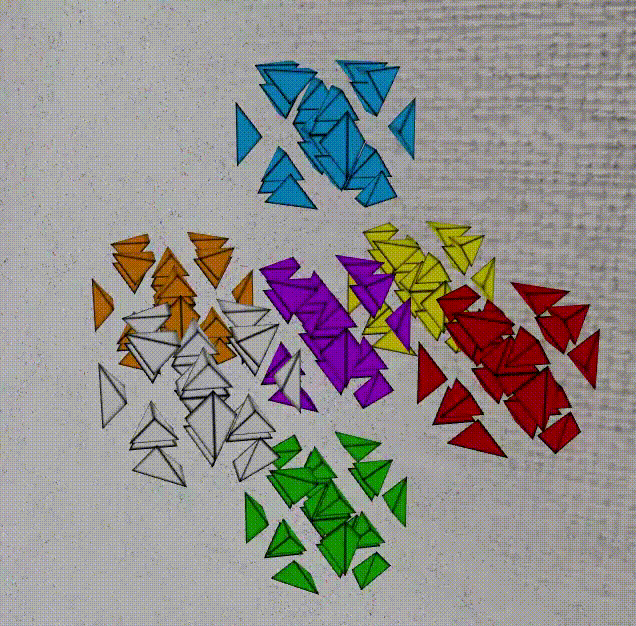
X- <-> X+ and Y- <-> Z+)It is a huge relief that we don't have to worry about Octahedra anymore. I am quite confident that we can combine the two 2-cycle to form a new 3-cycle. and 3-cycle means nothing can stop us from solving octahedra and also keeping other pieces intact at the same time.
In short, let's consider octahedra at the very last of the solve.
This is not trivial. We have to forge something affecting less tetrahedra. Anyway, let's try combining the two and see what happens. Specifically, try this sequence A0,A0,A1,A1,

It turns out it is a 21-cycle, (A0,A0,A1,A1)x7 especially affecting only 3 pieces,
X+O4 -> Y+O6 -> Z+O2
It's almost like a O5 twist on W-, right?
Anyway, now we have the two weapons we need, and I believe they are enough for the total solve. By the way, let this sequence be
X,X,6,6,Z,Z,Z,7,7,0,0,0,2,6,6,2,2,6,7,4,x,x,2,2,6,6,5,5,6,0,1,0,0,6,6,1,6,Z,Y,Y,x,x,z,y,0,0,Y,y,x,0,Y,Y,X,2,x,A4,X,2,2,x,y,y,0,0,X,Y,Z,4,4,y,X,3,2,x,A4,X,2,2,3,3,x,Y,4,z,X,2,6,6,5,6,x,A4,X,6,6,5,5,6,2,2,x,x,7,x,y,A4,Y,X,7,7,X,Z,4,4,7,7,x,y,A4,Y,X,7,4,z,A7,A7,Z,y,X,Y,z,A7,A7,y,x,Y,z,A7,X,A7,Z,y,6,6,1,x,Y,A4,y,X,1,1,6,Y,X,X,y,z,A7,y,A7,A7,X,4,x,4,X,5,5,4,4,2,x,A4,X,2,2,4,5,x,4,4,X,4,4,x,y,y,X,A7,A7,x,2,0,3,4,4,x,A4,X,4,3,3,0,0,2,2,X,y,0,0,Z,0,0,1,1,6,6,x,y,y,A4,Y,Y,X,6,1,0,z,0,Y,Z,y,X,Y,z,A7,X,A7,4,4,Y,2,2,1,1,6,x,A4,X,6,6,1,2,y,4,x,Z,Y,x,A4,X,y,z,X,1,z,X,X,Y,4,3,2,4,4,x,A4,X,4,2,2,3,3,4,4,y,x,x,Z,1,1,Y,z,y,x,A7,x,x,A7,X,y,x,y,A7,A7,x,y,y,A7,x,X,2,0,0,3,4,4,x,A4,X,4,3,3,0,2,2,x,A7,X,2,0,0,3,4,4,x,A4,A4,X,4,3,3,0,2,2,x,z,z,x,y,X,5,5,2,x,A4,X,2,2,5,x,A7,X,5,5,2,x,A4,A4,X,2,2,5,x
With
A0 = 0,1,1,0,0,1,0,1,1,0,0,1,0,1,1,0,0,1,0,1,1,0,0,1,0,1,1,0,0,1,0,1,1,0,0,1,0,1,1,0,0,1,0,1,1,0,0,1,0,1,1,0,0,1,0,1,1,0,0,1,0,1,1,0,0,1,0,1,1,0,0,1,0,1,1,0,0,1,0,1,1,0,0,1,0,1,1,0,0,1
A1 = 0,1,0,0,1,1,0,1,0,0,1,1,0,1,0,0,1,1,0,1,0,0,1,1,0,1,0,0,1,1,0,1,0,0,1,1,0,1,0,0,1,1,0,1,0,0,1,1,0,1,0,0,1,1,0,1,0,0,1,1,0,1,0,0,1,1,0,1,0,0,1,1,0,1,0,0,1,1,0,1,0,0,1,1,0,1,0,0,1,1
A2 = A0,A0,A1,A1,A0,A0,A1,A1,A0,A0,A1,A1,A0,A0,A1,A1,A0,A0,A1,A1,A0,A0,A1,A1,A0,A0,A1,A1
A3 = 0,1,0,0,1,1,0,1,0,0,1,1,0,1,0,0,1,1,0,1,0,0,1,1,0,1,0,0,1,1,2,5,5,2,2,5,2,5,5,2,2,5,2,5,5,2,2,5,2,5,5,2,2,5,2,5,5,2,2,5,0,1,0,0,1,1,0,1,0,0,1,1,0,1,0,0,1,1,0,1,0,0,1,1,0,1,0,0,1,1,2,5,5,2,2,5,2,5,5,2,2,5,2,5,5,2,2,5,2,5,5,2,2,5,2,5,5,2,2,5,0,1,0,0,1,1,0,1,0,0,1,1,0,1,0,0,1,1,0,1,0,0,1,1,0,1,0,0,1,1,2,5,5,2,2,5,2,5,5,2,2,5,2,5,5,2,2,5,2,5,5,2,2,5,2,5,5,2,2,5
A4 = A3,X,5,x,A3,X,5,x,A3,X,5,x,A3
A5 = 0,1,0,0,1,1,0,1,1,0,0,1
A6 = A5,A5,A5,A5,A5,A5,A5,A5,A5,A5,A5,A5,A5,A5,A5,A5,A5,A5,A5,A5,A5,A5
A7 = A6,y,y,Z,Y,X,y,x,Z,A6,A6,z,X,Y,x,y,z,Y,Y
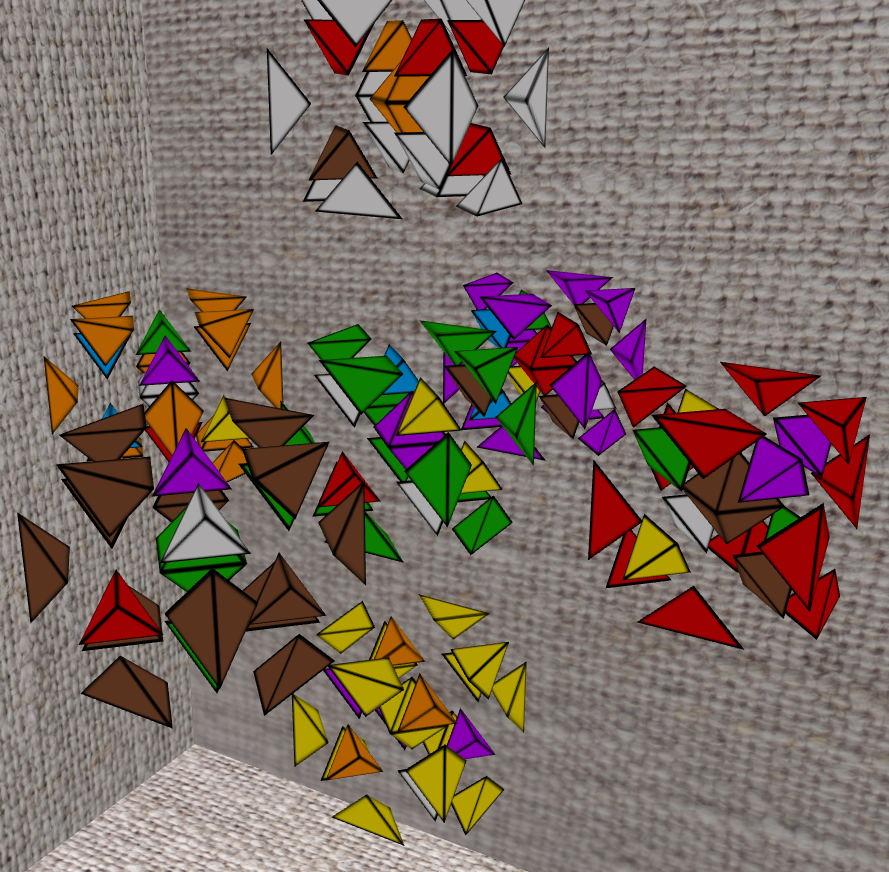
Yeah, it is a mess. Let's see what we can do on this. Before we are hitting any constraint, Let's do some random trials.
Send the red back,
A2,
Next? settle a yellow,
y,6,A2,
Next? settle a pink and a green together,
Y,Z,A2
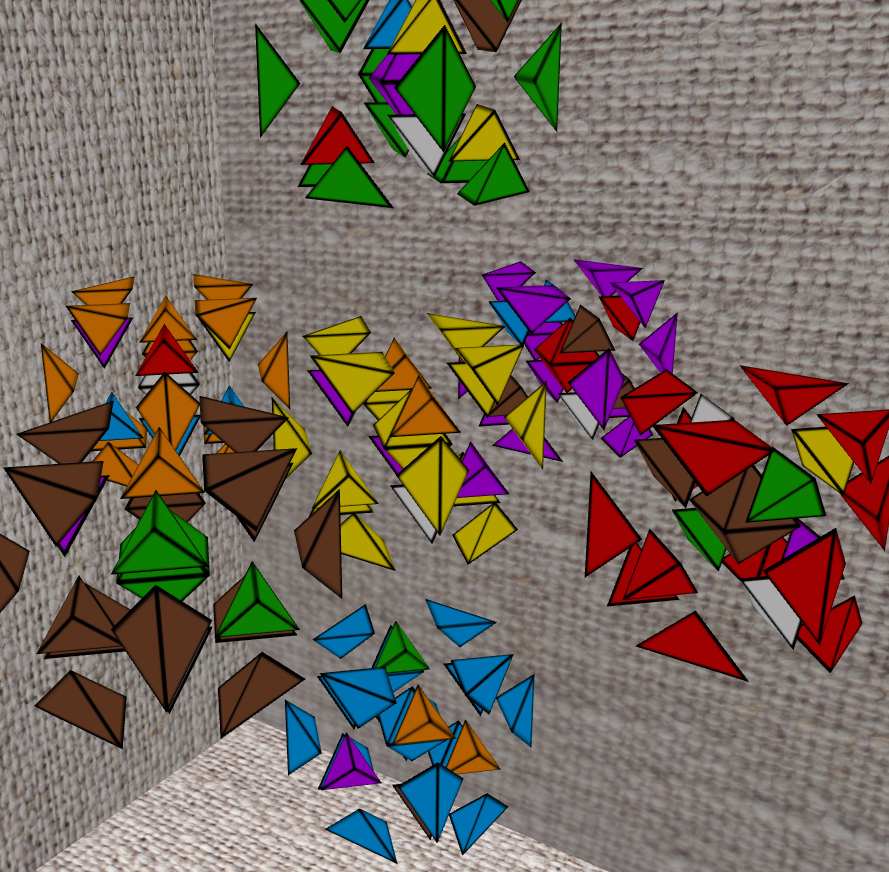
Oops, forget to resume the edges
z,y,6,6,
Next? I would like to do something to the white in pink,
X,Y,A2,A2,
Are we moving forward? Sure we do. We didn't break any thing, and we keep finishing some tetrahedra. Then,
y,1,A2,1,1,
There are a lot of blues in pink,
z,z,A2,
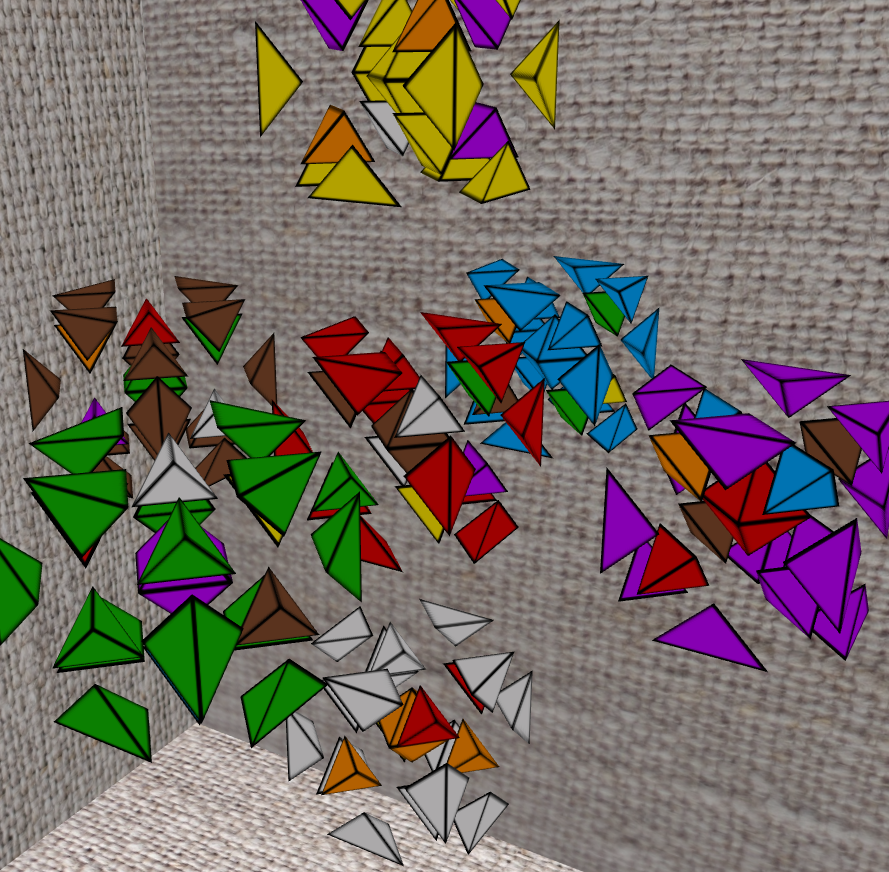
Then, we haven't try to put blue cell at X+ before. Finish a blue and a green at the same time,
y,X,1,A2,1,1,
Then, fix one more green in blue,
Z,Y,1,A2,1,1,
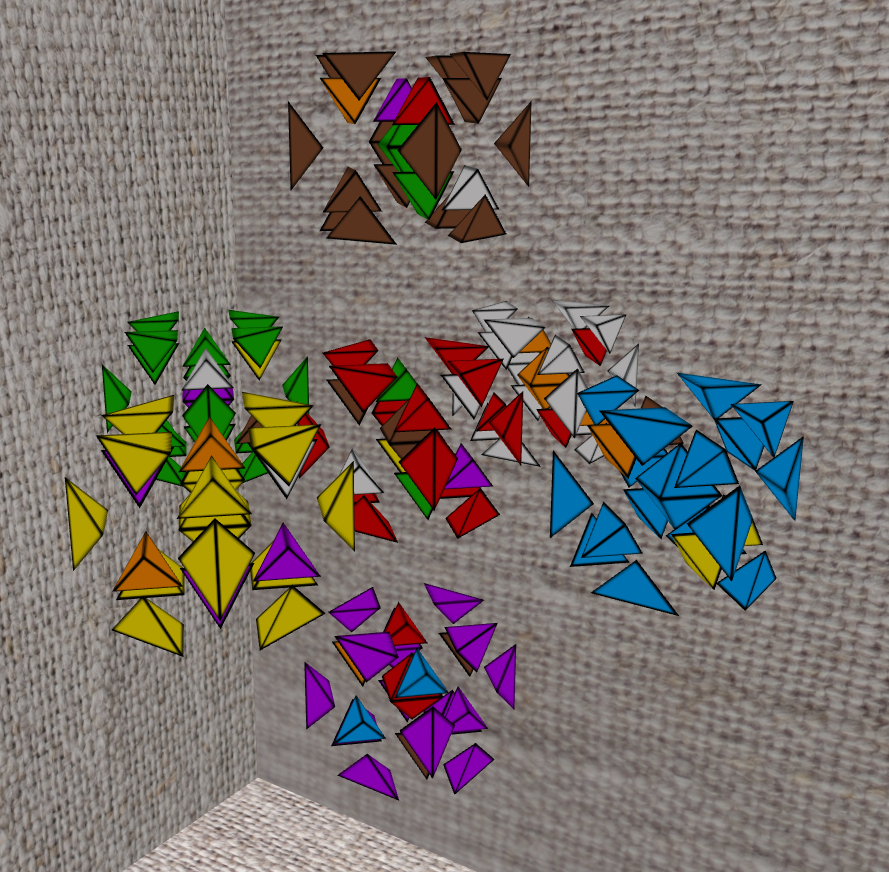
Yes, in case the reader hasn't discovered this fact, I will just say it. I follow my feelings more often than most of those who really know me in person, and also for a longer time than I myself expected. The above sequences are just gut feelings, not some calculated moves and can be stupid. Applying 3-cycle is playing safe. I just don't have that amount of focus to read the whole puzzle, so I instead move it slowly.
But now we have already played a while for now, a rule of thumb emerges. Our main focus is the X+O4, so it must not be moved before the key A2 move. That is to say, O0, O3, O4 and O7 twists are out, because they just move X+O4 away in terms of the cube-minus-tetrahedron polyhedron. O5 is a no go either, because it moves X+O4 away with the X+O4-tetrahedron. The rest three are safe: O1, O2 and O6. Any combinations of the three will be valid for setting up.
There are technical difficulties. My sight is blocked all the time, so it is often hard to tell what to go next. Also, after some interleaving O1/O2/O6 twists, the edges will be broken everywhere, so it becomes harder to tell where the A2ed center tetrahedra will go after setup moves are reversed. Despite of all theses challenges, I think we just try our best.
Although the blue cell in X- does not play the main role, a pink in orange is fixed.
Z,Z,Y,A2,
Fix a red in blue,
2,2,A2,A2,2,
Another change to fix a red and an orange!
z,2,2,A2,2,
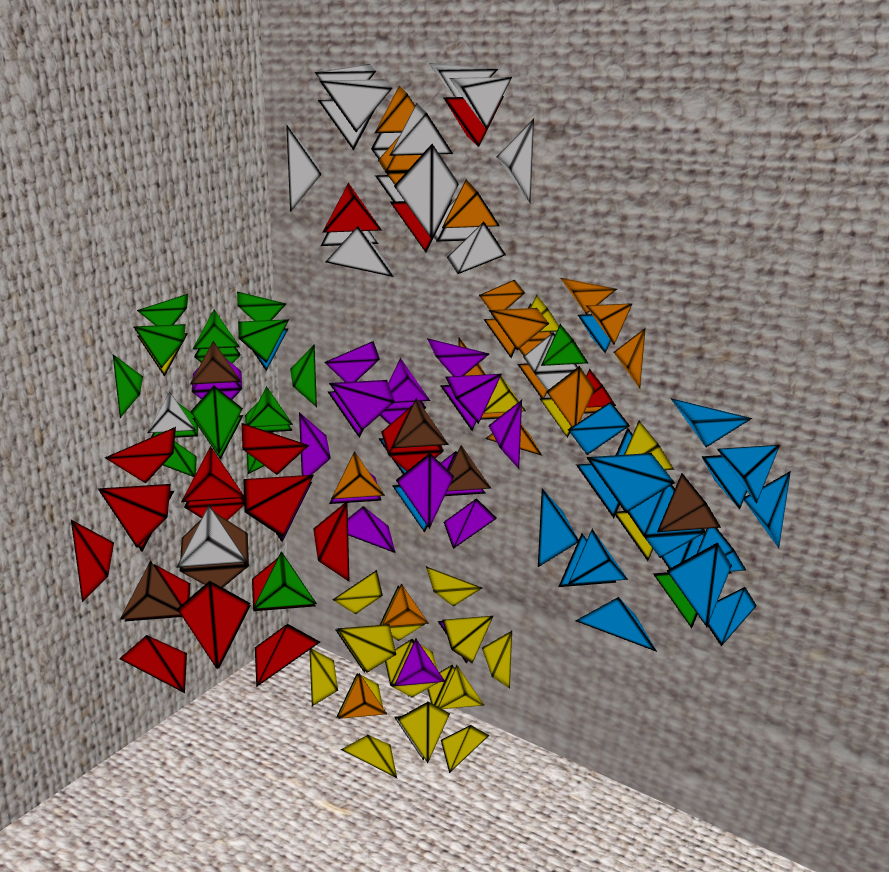
Turns out that the green in blue is fixable, and also get a blue back,
1,A2,1,1
The move shift a pink out but also a pink in, so it should be fine,
Z,6,A2,6,6,
Do somthing with yellow,
X,A2,A2,

Still want to do something with pink in yellow, so set one more pink. Note that the (Y,z)x2 move is a techinque to fix X+O4. Theoretically, if the system was implemented better at the first place, like MC4D 2x2x2x2 that offers control to all cells, we whouldn't have to perform tricky rotations over and over again just to setup a perfect angle. Anyway...
Y,Y,Y,z,Y,z,1,A2,A2,1,1
Fix a orange here,
y,A2,
And I want the yellow in blue back as well,
6,6,A2,6
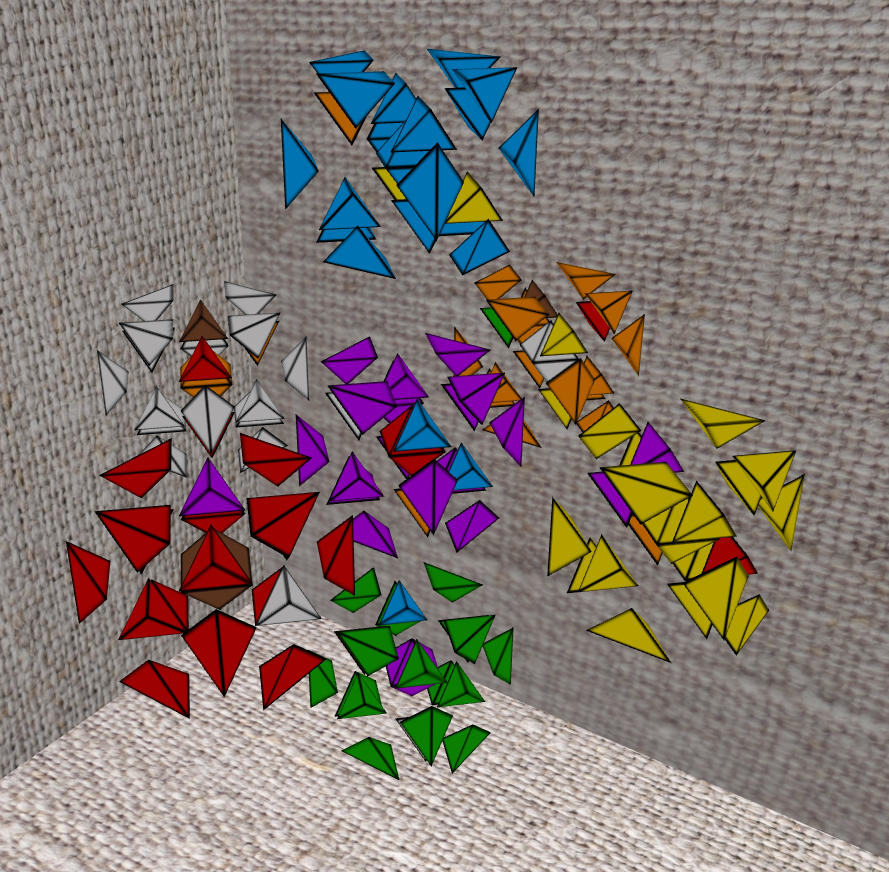
How many are there still left to be fixed?
So far it is just tedious, but it is still hard to say. Maybe in the late stage, we will encounter some difficult constraints?
30 left...
Focus on the Z+O2 can also help,
7,7,A2,7
Fix a yellow,
Y,Y,6,A2,6,6
Set coffee cell to X+ to see if there is anything we can do. Yes, fix a orange,
X,2,2,A2,A2,2,

Fix a red,
Z,A2,
Fix a orange,
Y,z,6,2,A2,2,2,6,6,
Why is the white cell such a mess? Fix one,
X,X,Y,Z,Y,x,6,6,4,A2,A2,4,4,6
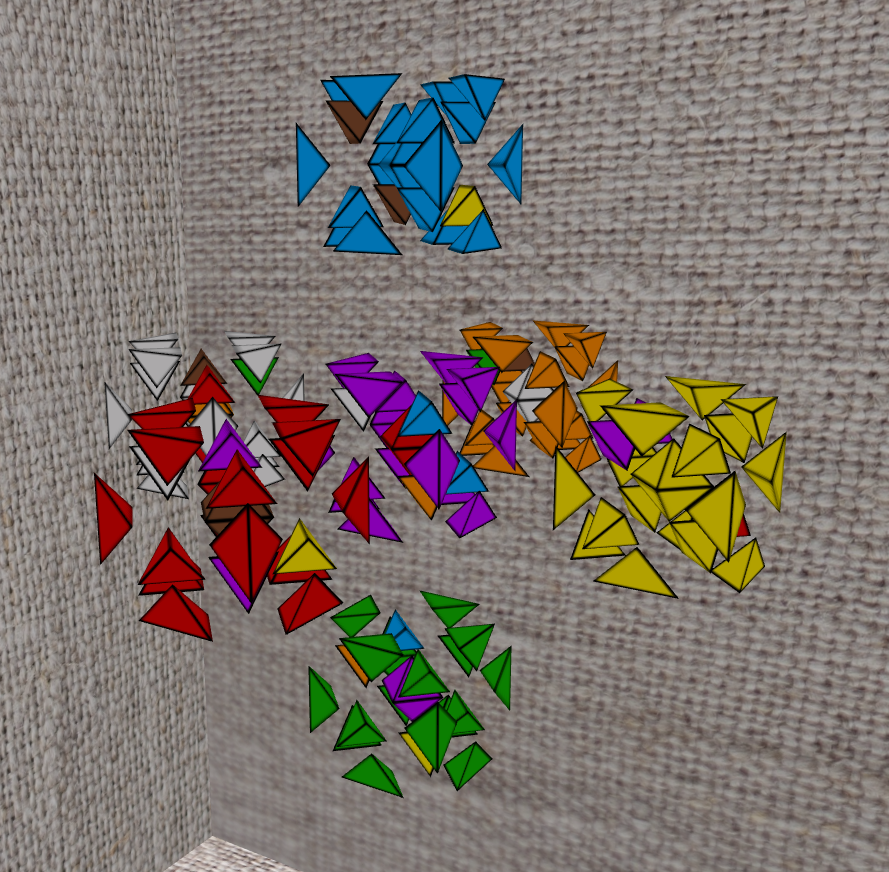
Fix a coffee,
Z,4,4,A2,A2,4,
Fix a green,
Z,A2,
Fix an orange,
Y,z,A2,A2,
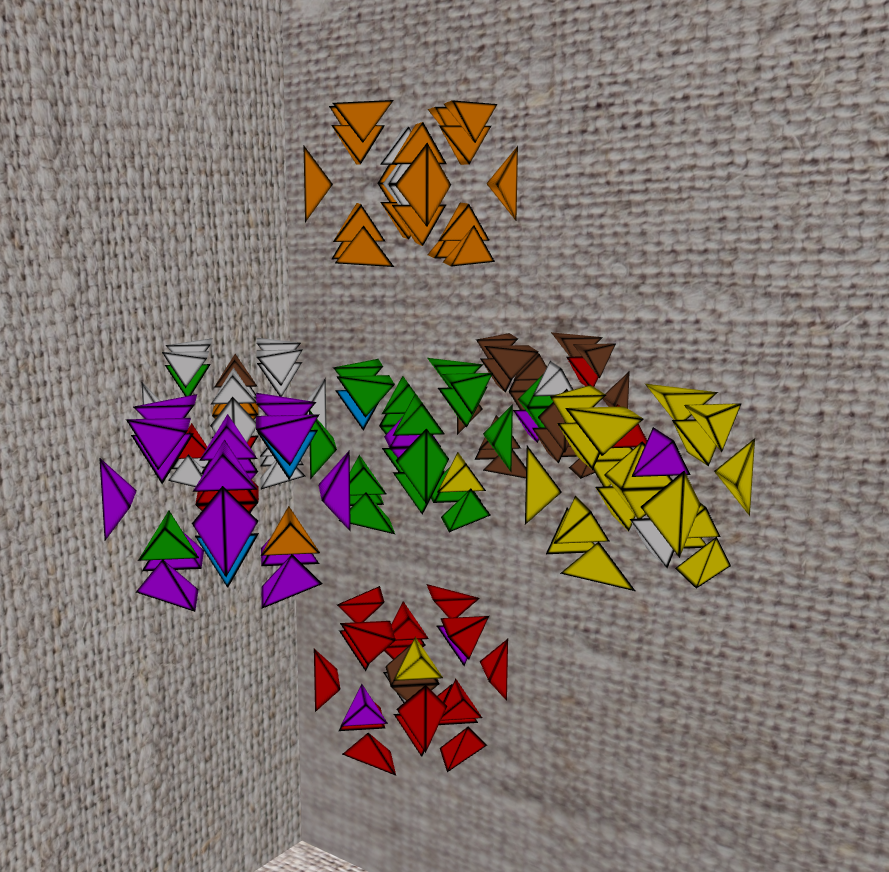
Fix a white,
Y,z,6,6,A2,6
Fix a blue,
z,4,A2,A2,4,4,
Fix a yellow,
A2,
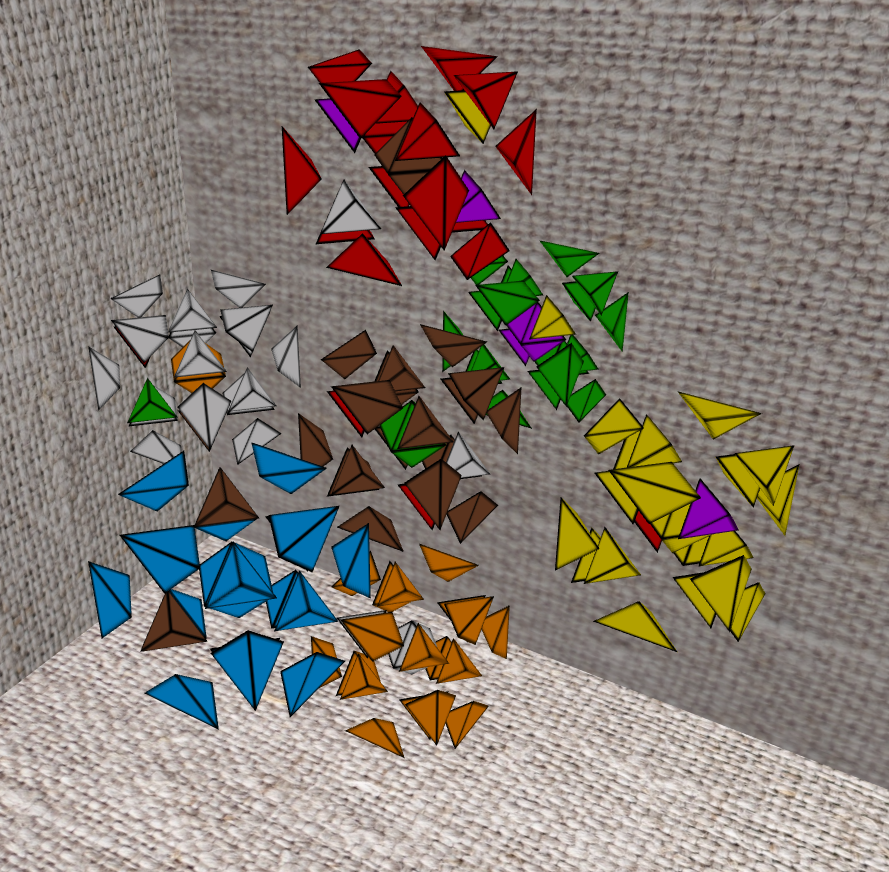
Fix a pink,
Y,Y,X,A2
During the past few trials focusing on Z+O2, I regularize a sequence, Y,z,x,z,X,Z, for fixing Z+O2 to see if there is any other chances. With this condugate sequence, we can include W-O5 as a hidden member of the A2 3-cycle. In other words, as long as there are 3 pieces out of X+O4/Y+O6/Z+O2/W-O5 is not a fixed tetrahedron and also some of them has the chance to return its cell, A2 is helpful in this case. Other than that, either we need different condugate sequences, or we should rotate the whole puzzle to a better position.
Or, the worst case, A2 alone is not enough for fixing all tetrahedron? It is possible. I currently have no knowledge to judge its possibility. Anyway, be prepared to discover new algorithm for this. Though far from desparate, it is not optimistic for now. The time required to mine a fix is getting longer. I think after a few more fixes I will start looking for new algorithms.
Keeping red in Z+ and skipping blue/yellow/pink in red, fix the white,
y,X,X,X,Y,z,x,z,X,Z,7,4,A2,4,4,7,7
After red at Z+, I examine pink at Z+ because it has 3 non-fixed tetrahedra, but somehow I cannot find A2-fitted way to have more progress. What about the yellow in green? After the rotation move, we can fix a blue,
Z,X,Y,z,x,z,X,Z,6,A2,6,6

The fix encourage us a bit because, when the pick cell was at Z+, we didn't find any chance to proceed, but the piece in it can still participate other 3-cycle that we were not able to find out. Interesting. Apparently there is still lack of serious deduction or conclusion if A2-only strategy is sufficient or not, but let's just keep moving otherwise this series will end miserably.
Lucky enough, with more O6 twists, we can return the new coffee in green to its cell,
6,6,A2,A2,6
Funny, the yellow goes back to green. See if yellow in green can bring us more good luck, and yes it can. After the rotation sequence with one more O4 twist, we see the chance to proceed from the pink in red. So two more rotation sequences,
Y,z,x,z,X,Z,4,Y,z,x,z,X,Z,Y,z,x,z,X,Z,A2,A2,
And of course we have to resume it,
z,x,Z,X,Z,y,z,x,Z,X,Z,y,4,4

Previously, we always treat O5 twist as a prohibited move because it changes the state of the core part of A2. Is it really that so? Although the absolute position of each pieces is changed, they remain the same relation among others in the 3-cycle. This gives me some hint about the next step, starting from twist O4 again to summon the yellow in red back. After applying the O5 twist and two more O4 twists, a 3-cycle of yellow in yellow, red in green and yellow in red emerges. Do it to fix one red,
4,5,5,4,4,A2,4,5,4,4,
Again we have a yellow in green there in the Z+O2! This time it is a different yellow piece though. The one that brought us so much luck is home now. Keep playing with this yellow in green set, fix the green finally,
Y,z,x,z,X,Z,Y,z,x,z,X,Z,4,Y,z,x,z,X,Z,Y,z,x,z,X,Z,4,A2,4,4,z,x,Z,X,Z,y,z,x,Z,X,Z,y,4,4,
Adjust pink in green at Z+O2, and another pink in red is at X+O4. After some trials I didn't proceed a bit from this combo, so I do a O4 twist to move the pink in red away. Removing non-fixed change away is a new move I never tried before, but this time it looks good. We happend to be able to get the white in orange a part of the 3-cycle, and fix it in white,
y,X,X,Y,z,x,z,X,Z,4,z,x,Z,X,Z,y,4,A2,4,4,Y,z,x,z,X,Z,4,4
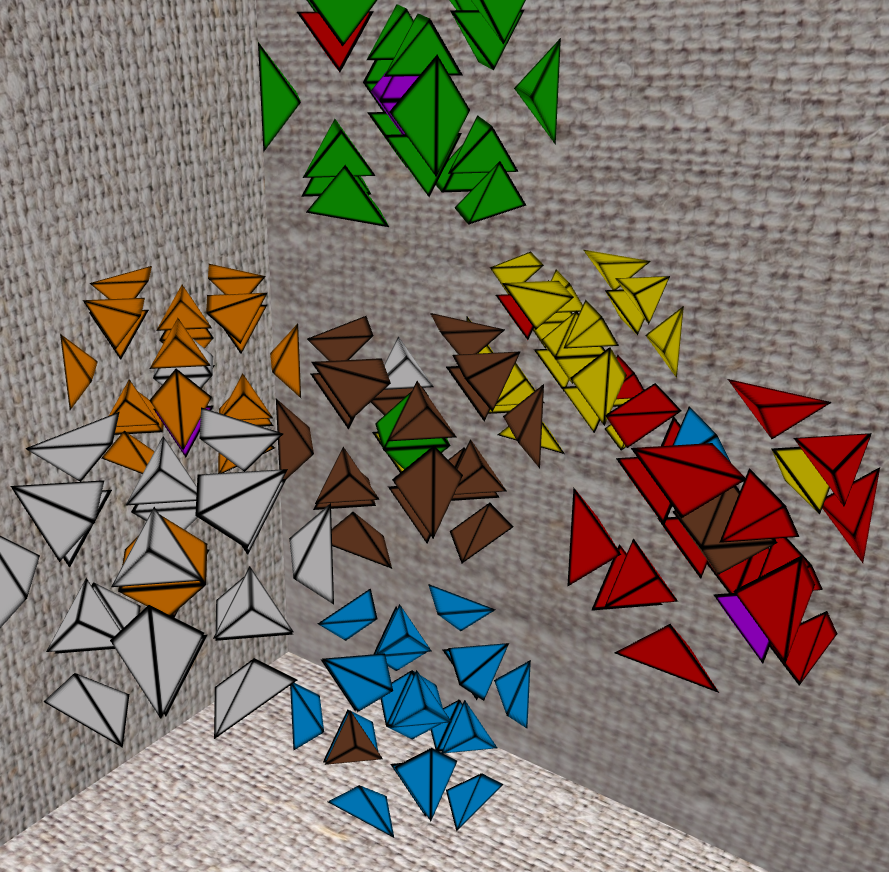
Now we have red in green at Z+, and red in X+, but seems no obvious 3-cycle member fits Y+. After a rotation and O4 twist, we can find a almost perfect fit: a pink in orange. This mean that, we can fix one red and one pink in this round,
z,x,Z,X,Z,y,4,A2,A2,4,4,Y,z,x,z,X,Z
How many are there still left to be fixed now?
12 pieces left!
I kept mentioning luck along the way, because I really meant it. I have just put pieces here and there, and tried to move the rest of the puzzle to see if any useful pattern emerges so that A2 can be applied. But now the non-fixed pieces are sparse, it takes so much longer to fix any of them. Improvement on methodology is required.
An attempt is like this: augment the A2 core algorithm, as Z,A2,z. This changes the expanding 3-cycle into a inner one, W-O2 -> X+O3 -> Y+O1. The differences to the original one is, the center regular tetrahedra in W- never change its position if no rotation move is applied. Thus theoretically, all 8 kinds of twist can be used to fit appropriate pieces into the 3-cycle.
Some more analysis here. All regular tetrahedra pieces in the X/Y/Z cells can be separeted into 2 groups: the W+ and the W-side. For a W+side tetrahedron, 5 kinds of twist can move it (the twists that affect it all 4 octants that near the cell it belongs to and 1 other octant); for a W-side tetrahedron, it is 3. To me, this is summary instead of plan beforehand. After the practices so far, I am far more familiar with the twists of this puzzle now. However, it still consumes a huge amount of working memory and space recognition attention because all twists affects 6 visible cells and the pieces in them.
Anyway, from now on, let's view the Z,A2,z sequence as our core algorithm, but I won't directly rewrite A2 otherwise the history will be corrupted.
With the new sequence in mind, center the green to W- first. 3 is to highlight green in pink. 2,2 is to move it to Y+ cell's W+ side. To fix it while remaining the ability to change X+O3, the available twists are O5 and O3/O4. These two set of twists have different power. While O3/O4 can directly change X+O3, O5 only serve as a modifier to tweak the situation. Hopefully that's enough for us. Anyway, after 3,3, the green in pink become fixable since the other pink in orange joins this 3-cycle,
z,3,2,2,3,3,Z,A2,z,3,2,3,3,
In a very similar course, we fix the pink in orange as well,
y,X,X,z,3,2,2,3,Z,A2,z,3,3,
Without fully resume the setup, we keep the pink in yellow at Y+, and find some other fixable pieces. Technically I didn't find new ones to join the 3-cycle, but the pink in yellow itself can go back to W-. So a twist O4 to move red cell to X+,
4,Z,A2,z,4,4,2,3,3,
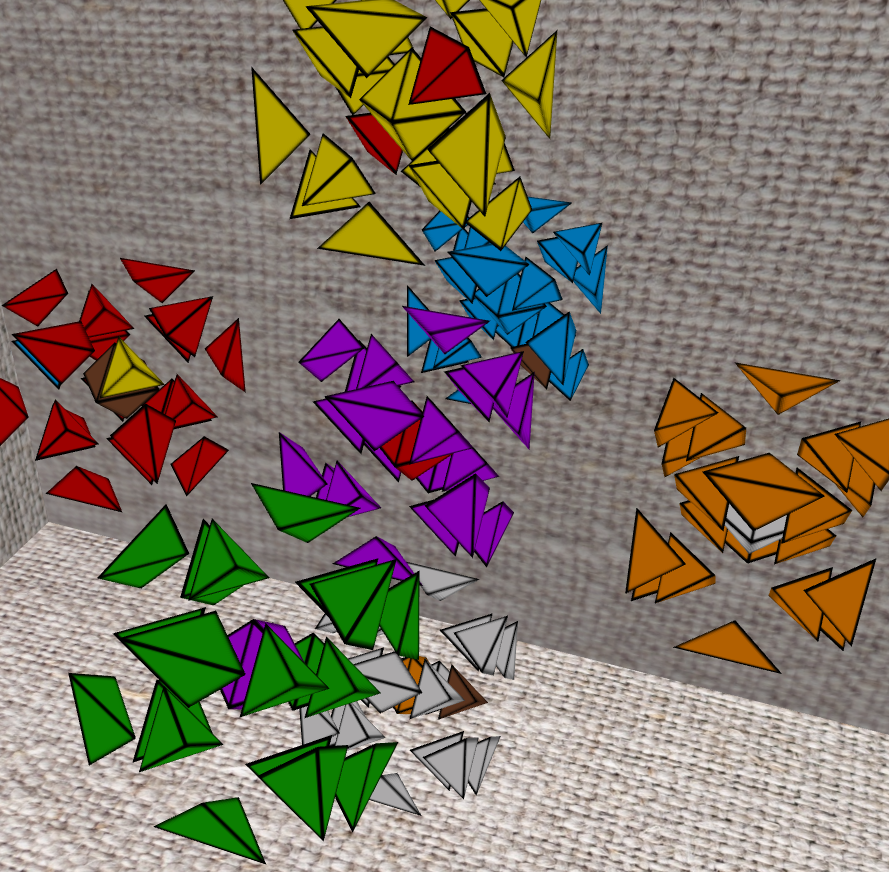
Still two non-fixed one in red? Center it and try to do something about it. 0,7 combo moves the coffee in blue diagnolly to our target position, Y+O1. Then 1,3 joins a coffee in blue, so we can settle two pieces in one Z,A2,z,
X,1,3,Z,A2,z,3,3,1,1
Center the white and give it a try. 4 to move the white in coffee to X+, and them 0,7 to move it diagonally to Y+O1, the position we want. The 5,4 is the setup for a red in yellow
X,X,y,x,Z,4,0,7,5,4,Z,A2,z,4,4,5,5,7,7,0,0,4,4,
OK, there are 5 left. They are
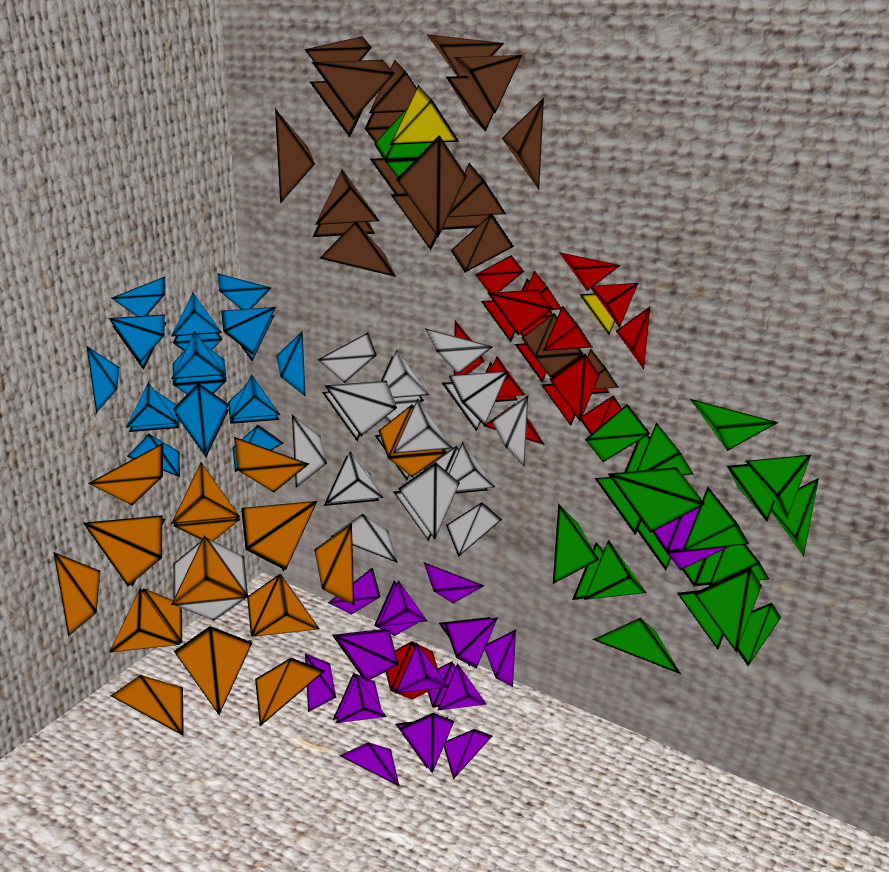
Maybe we can fix the coffee first?
X,z,4,3,Z,A2,z,3,3,4,4

It's so close now, but I don't know clearly what to do next. Inevitably we will have to clobber some fixed cell as a temporary state.4 left, but I trongly feel that no more low-hanging fruits anymore. I want to try some swap steps. Swapping is nothing new, in some previous fixes we do swap finished piece out of it home cell, but we have been making sure that the piece going to the position is also a piece of the same color. Now we are going to do it intentionally.
I choose pink as the swap space,
X,X,Z,A2,z
It's too tiresome to condugate myself. My working memory is drained. What a Friday night, what a month. I just start my multiple browser tabs to explore the following sequences
And of course their siblings. They are all 3-cycles. This is useful for us to move on a bit. Fix a red,
Z,(A1,A1,A0,A0)x7x2,z
These sibilings are cool. Concatenating two of them, and we have a 3-cycle that performs Y+O5 -> Y+O1 -> X+O3. With this inner-cell thing, we can move pink to X+, (call this sequence the sibiling)
Y,5,y,Z,(A1,A1,A0,A0)x7,z,Y,5,5,y,Z,(A1,A1,A0,A0)x7x2,z
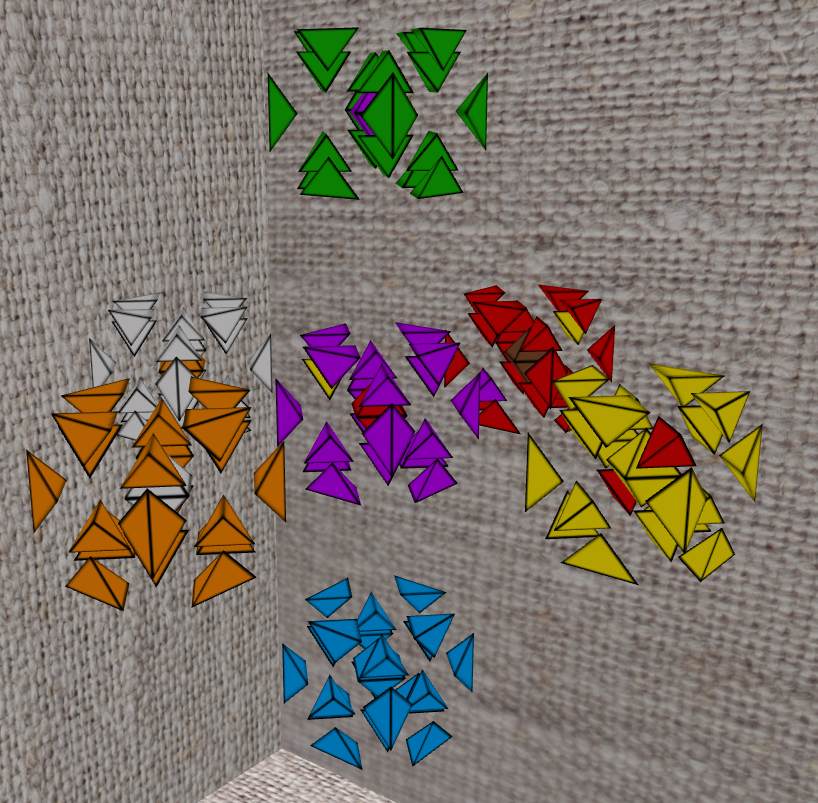
What a setup! If you haven't got it, check this, by applying yet another
Z,(A1,A1,A0,A0)x7x2,z
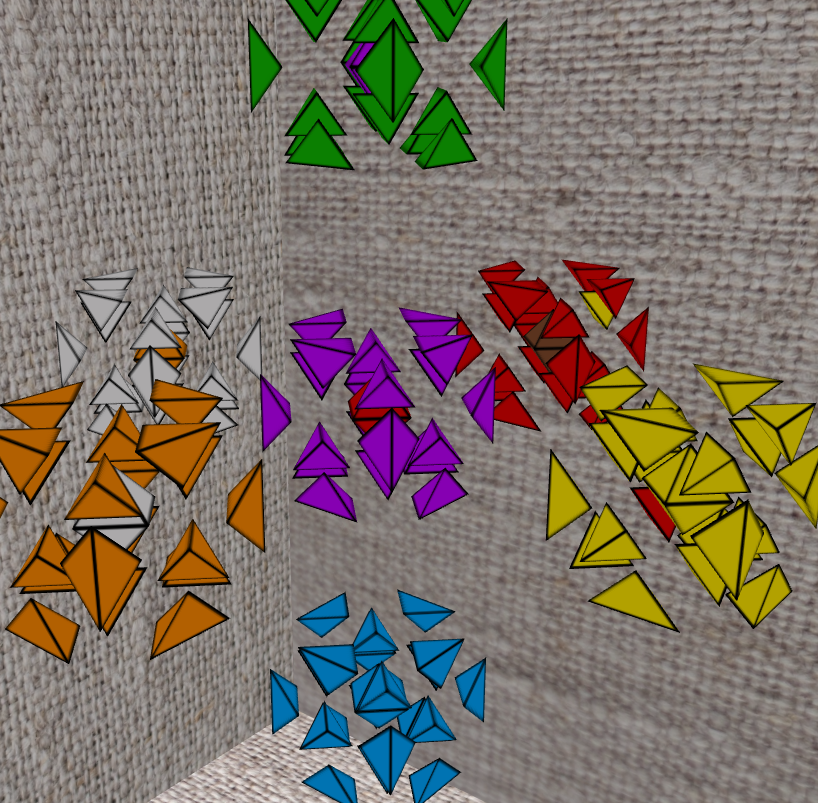
Now we only have two tetrahedra left. It is pretty tricky to setup, but I somehow nailed it. Z,x,x to settle the yellow in red to the X-side, and then 2,2,3,3 to move red in yellow back to X+O7, 2 to move a red tetrahedron at Y+O1. The 3-cycle is then formed by a red-red-yellow
Z,x,x,2,2,3,3,2,(X,4,x,the sibling,X,4,4,x)x2,2,2,3,2
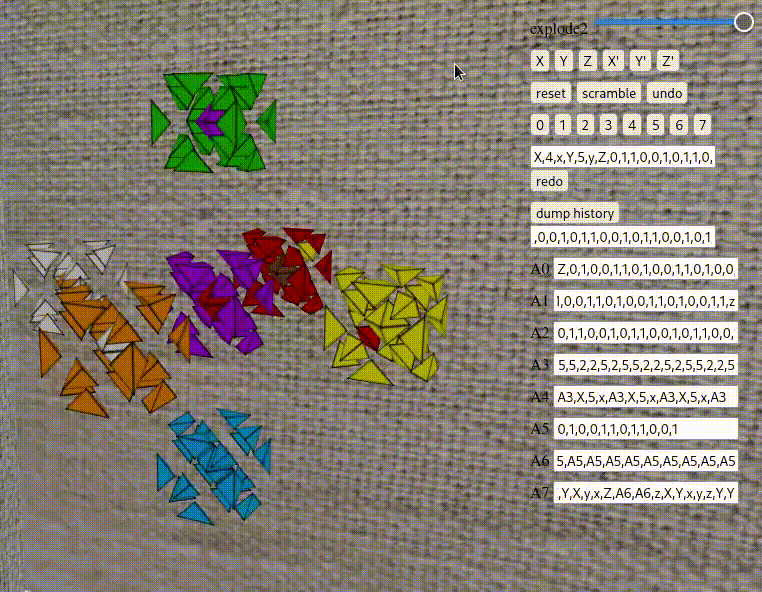
Come on! Hell yeah!
Calm down, some analysis first. For now,
X- <-> X+ and Y+ <-> Z+
X- <-> Y+ and X+ <-> Z+
Y,X
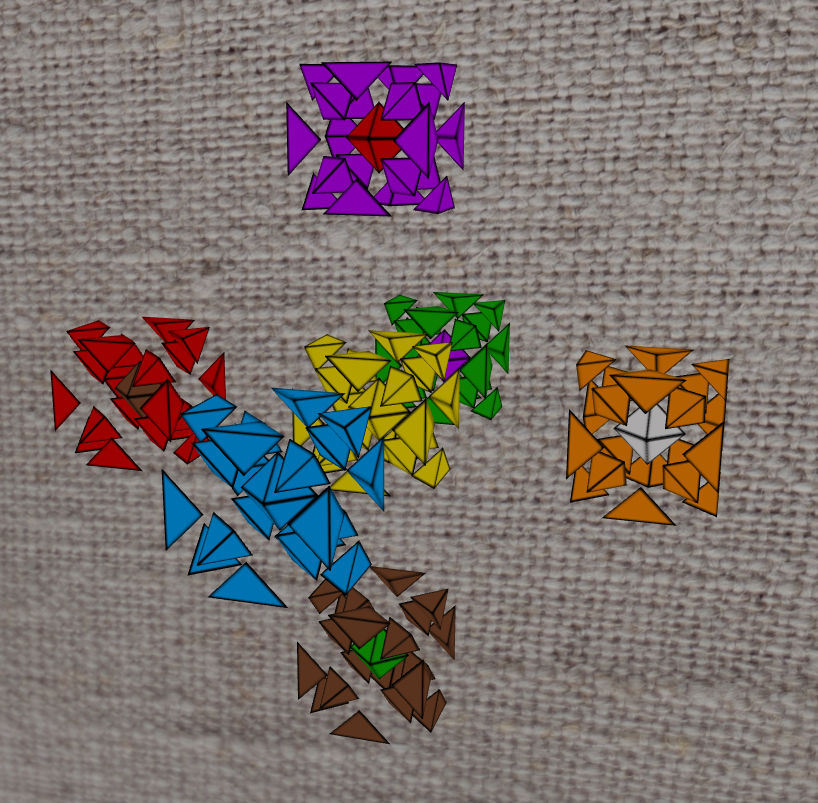
Applying AA0 to solve the pink at Z+. Then, move the finished Z+ down to a invariant position. Specifically, Y-/Z-/W-/W+ is not affectted.
AA0,z,
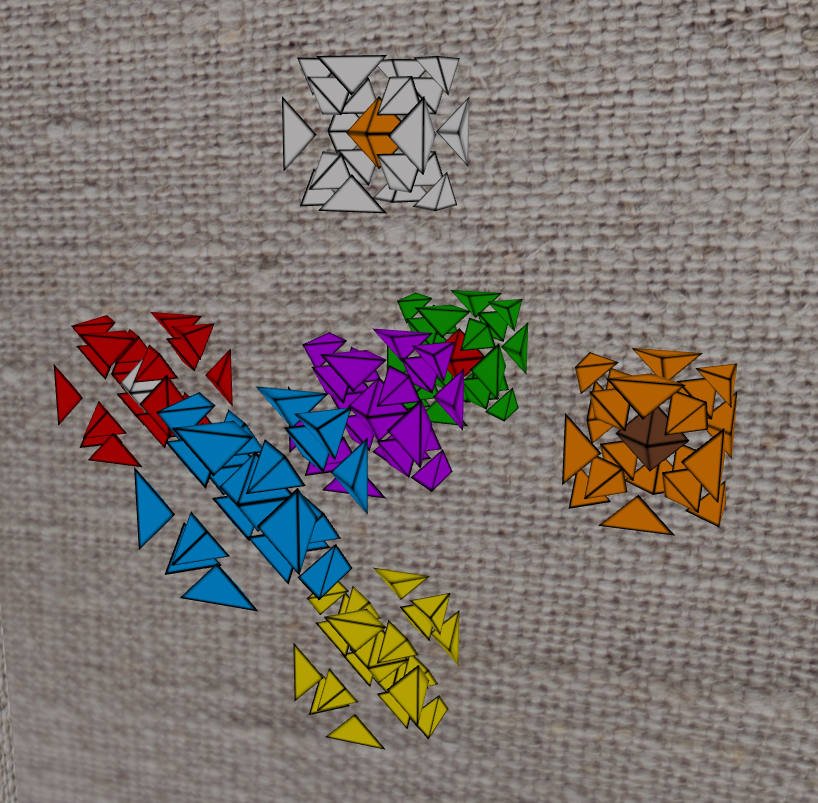
If we go with AA1, we will solve orange and red at the same time. With 3 cells left, oh, I have no more energy to find a 3-cycle. If we go with AA0, we solved nothing. So I decide to move one more cell down, and go with AA0,
z,AA0,

Intuitively, we can push Y- cell so that the rest 4 can be ready at the valid positions. The 2-cycles we need is, hmm... X- <-> Z+ and Y+ <-> X+. I believe combining the AA0 and AA1 can solve this situation,
Y,AA0,AA1,
I was so high when finishing the regular tetrahedra pieces (what a nightmare... to me it was just a few minutes ago. I said I did all this in real time, 9/30, didn't I?), so I hardly feel any emotion on the final solve. That was crazy. This Ironman series was a whole bunch of crazy mess. The true conclusion is to be written tomorrow. It has been too much for me now.
首次解開轉亂的 4D skewb。鐵人賽衝刺結束。明日留有真終章。
